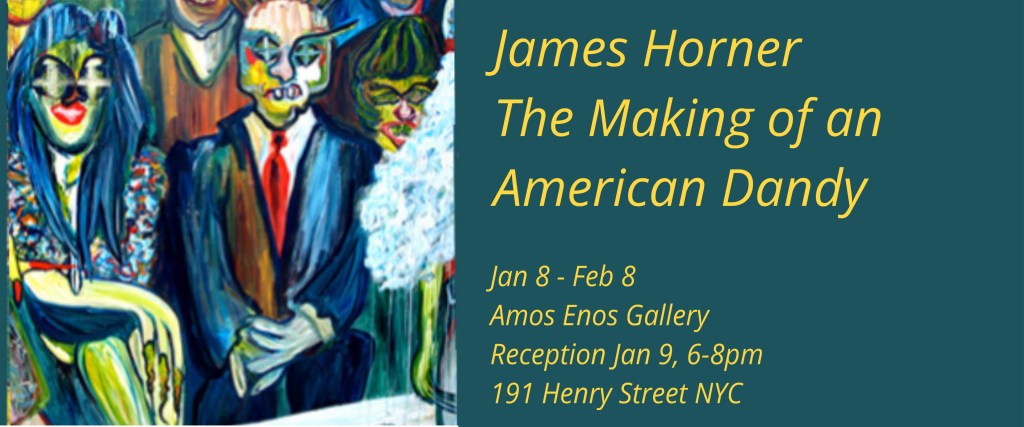
Contributed by David Carrier / Artist and art writer Joe Fig is interested in how contemporary art is made, viewed, and judged. His book Inside the Artist’s Studio provides a fascinating perspective on the role of the studio. The archly clever paintings in “Contemplating Compositions,” his solo show at Cristin Tierney Gallery, drill down on the presentation of art. Fig’s paintings show people looking at it in museums and galleries. They are small enough to fit into carry-on luggage, and so meticulously painted that they at first appear to be photographs. Unlike photographs, however, they don’t induce vanity. Whereas Thomas Struth’s famous 1990s shots of spectators in churches and museums seeing art made me feel as though I should wear a nice Italian suit to the Prado, Fig’s paintings allow the spectators, generally with their backs turned, to keep their privacy as they view the work indicated in the title. We are given no sense of the identities, conversations, or social status of these spectators. The premium is on seeing, not being seen.



14 x 14 1/2 inches
Old masters and modernists alike have employed the device, now repurposed by Fig, of the picture within the picture. In Vermeer’s The Love Letter, behind the maid who is handing the lady a letter are paintings showing the stormy sea and a traveler in the countryside. Vermeer thus suggests his depicted lady’s thoughts about her turbulent romance with that traveler. Likewise, in Degas’ Sulking, behind the woman leaning across the desk of a man who is turning away from her is a British racing print showing a horse refusing to jump a hurdle. The pictures within the picture, like balloons in cartoons, present the unspoken thoughts of the figures, inducing self-consciousness about the nature of representation. Fig intentionally uses pictures within pictures more enigmatically. It is unclear whether the two people viewing Andy Warhol: 2 Self Portraits (1964, 1966)/Art Institute of Chicago are admiring the Warhols or moralizing critically. Are the viewers in Anna Weyant: Loose Screw (and Keith Haring)/Christie’s preparing to make a bid?

The title “Contemplating Compositions” offers some hints about Fig’s intellectual embrace of these meta considerations. The gallery handout says:
When we contemplate an artwork, we often distill a piece down to its elements, analyze what we see, and form opinions. We uncover what is being communicated. Similarly, when making work, artists frequently pause to take a step back, look, and reflect. Contemplation is as intrinsic to the creative process as the actual physical work of making an object.
For all that solitary thought, though, a work of art is unfinished until it is viewed by the public. And how the public views it is indeterminate. Contemplation is readily associated with the works of Brice Marden and Joan Mitchell – also subjects of Fig paintings on display – but not with Warhol’s self-portraits. Fig challenges that standard in associating extended looking with anti-aesthetic works as well as others. But how art is judged after contemplation is another matter still. That too remains up to the viewers, whose opinions of course vary. In Fig’s cagily conceived and targeted pictures, evaluations of the art on display are bracketed and therefore resolutely subjective. How then do we judge his aesthetic achievement against his original intent? It’s a logical and philosophical conundrum, and that may be his very point: to provoke vexing thought.
“Joe Fig, Contemplating Compositions,” Cristin Tierney Gallery, 219 Bowery, Floor 2, New York, NY. Through October 21, 2023.
About the author: David Carrier is a former professor at Carnegie Mellon University and Princeton University; Getty Scholar; and Clark Fellow. He has lectured in China, Europe, India, Japan, New Zealand, and North America. He has published catalogue essays for many museums and art criticism for Apollo, artcritical, Artforum, Artus, and Burlington Magazine. He has also been a guest editor for The Brooklyn Rail and is a regular contributor to Two Coats of Paint.























David, thank you so much for the thoughtful and considered review. If I can say, I so appreciate your contemplation. You made my day, week, month and year. Thank you!
David, a very thoughtful and well written review. The paintings offer us as viewers an additional bonus. People who stop to really contemplate art are artlovers, so what makes these works especially endearing to me is that I feel I am watching an act of love.